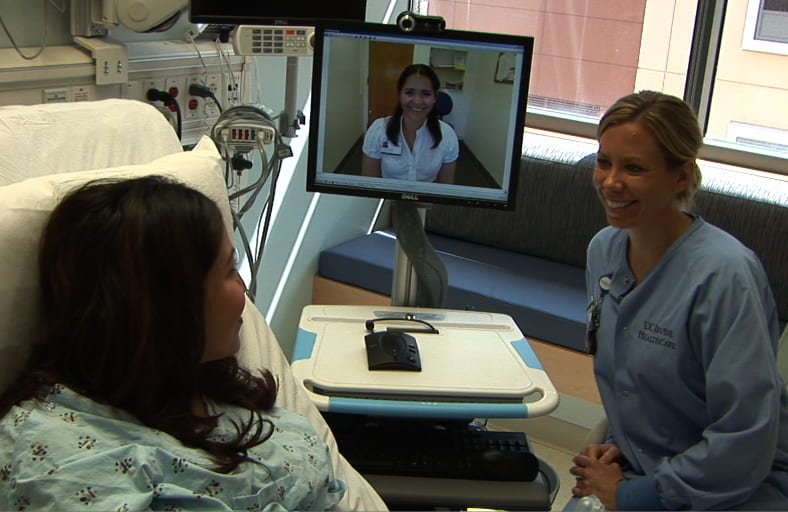Hospital tests video translation service
UC Irvine Medical Center tests remote medical interpretation for patients with limited English proficiency.

Gloria Guzman – or rather an image of her on a computer monitor – glides past the nurse’s station on her way to “see” another patient. She’s not a doctor or a nurse but nevertheless plays an important role in patient care. Guzman is a medical interpreter currently involved in a pilot project to determine whether remote video interpretation – with her image and voice transmitted over a two-way Internet connection – meets the needs of patients with limited English proficiency.
Medical interpretation at UC Irvine Medical Center is usually provided in person. Often, however, the doctor or nurse and the interpreter are not available at the same time, which can lead to delays in patient care. Remote video interpretation eliminates interpreter travel time, essentially providing an “on demand” service via a computer cart that can be rolled from room to room while the interpreter sits at a terminal elsewhere.
“Patients have the opportunity to ask questions in the language they’re most comfortable with,” says Tudy Trgovac, patient relations manager. Working with the medical center’s information technology department, Trgovac is testing the system in a few nursing units to work out the kinks and see how patients respond. If the pilot project is a success, the plan is to have enough carts on each floor that medical interpretation is available at a moment’s notice.
Bridging the communication gap between limited-English-proficiency patients and hospital staff is a safety issue. Relying on family members to convey important health care data is risky because doctors and nurses can’t be certain that what they’ve said is accurately translated. In January, The Joint Commission – the nation’s hospital accrediting organization – set standards for interpretation. And California’s health and safety code states that since basic health care is the right of every patient, access to comprehensible information about it is also a right.
Interpreters are most needed at UC Irvine for Spanish. The medical center also furnishes in-person Vietnamese translation and may consider the language for video interpretation in the future. Translation for less-common languages, such as Russian or Japanese, will continue to be supplied over the phone by a vendor offering more than 150 languages.
So far, the video system is being well received. “Patients seem surprised to see me on a computer screen, but they relax when they see how it helps them understand the doctor or nurse,” says Guzman. “This lets me quickly provide interpretation at different places.”
Staff has also welcomed the innovation. “This improves interaction with the patient,” says nurse Maureen Iwuoha. “We don’t have to spend time waiting for an in-person medical interpreter. We can keep things moving faster.”
During recent rounds, Dr. Ashish Kalthia checks in on a patient about to be discharged. After a brief explanation from an on-screen Guzman, the woman agrees to video interpretation. Kalthia speaks to her in English, explaining her treatment. Guzman translates, and the patient responds to the doctor in Spanish, also translated.
“This is better than the phone lines we used before, and it’s better than waiting for an interpreter to arrive,” Kalthia says. “The patients seem comfortable with it.”